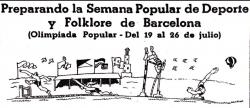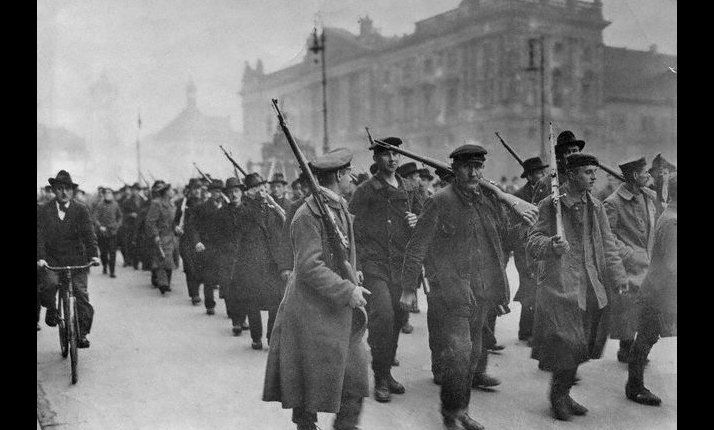Sport and Politics in an age of War, Dictatorship and Revolution BY RAY PHYSICK
In an attempt to undermine the IOC Games of 1936, organisations linked to the international worker sport movement responded to an invitation from the Comité Organizador de la Olimpiada Popular (COOP) to take part in an alternative Olympics, the Olimpiada Popular, in Barcelona in July 1936. It is estimated that some 10,000 athletes and 25,000 visitors were in Barcelona to celebrate the Olimpiada. Following the Fascist rising, which began in Spanish Morocco on 17, and reached mainland Spain the following day, the Games had to be abandoned, despite attempts by the organisers to go ahead with a truncated programme. This article will assess the importance of the Olimpiada Popular in the context of the worker sport movement during the inter-war years and its significance with regard to international campaign to boycott the Berlin Olympics.
‘If the armed front uses force, the cultural front has to open minds. I think the principal lesson of this cultural front is to unify people in every part of the world, people that have suffered a great deal, and continue to, from mendacious precepts of humanity.’
(Roberto Eduardo Matta – Chilean-born artist. Source is from an exhibition, Past Quiet, at the MACBA Gallery, Barcelona, 20 February – 1 June 2015)
Introduction (for complete article, see PDF archive)
During the inter-war years there was a vibrant international worker sport movement; a movement that organised several prestigious worker sports events including three Worker Olympiads and two international Spartakiads. The first two Olympiads and the Spartakiads reflected the split that had developed in the worker sport movement, between the Socialist Worker Sports International (SWSI) and the Red Sport International (RSI), in the immediate post-WW1 period. The former was organised under the banner of the Second (Socialist) International, the latter was associated with the Comintern, or the Third (Communist) International. However, following the rise of Hitler to power in 1933, the two movements agreed to bury their differences and organise a joint Worker Olympiad in Antwerp in 1937.
The agreement to hold a joint Olympiad reflected a wider change of political direction by the Soviet Union. Between 1929-1933 the Comintern, under the leadership of Stalin, regarded workers associated with social democratic parties as social fascists. This disastrous policy split the labour movement internationally, essentially enabling Hitler to come to power without the expected resistance of the labour movement within Germany. This resulted in a volte-face in policy by the Comintern: now not only were the social democratic parties allies in the struggle against fascism but they should, along with Communist Parties, form alliances with so-called progressive capitalist parties. This policy resulted in coalition governments in France and Spain, governments known as Popular Fronts. According to Gounot, the idea of establishing popular fronts extended into sport as early as 1934 when the RSI developed the idea of overcoming the divide within the worker sport organisations.
The main outcome of this was that the Communist and Social Democratic organisations agreed to organise the aforementioned Workers’ Olympiad in Antwerp in 1937. This change in tack was also reflected in the People’s Olympiad planned for Barcelona in July 1936. The Games were not to be a Workers’ Olympiad but a sporting event that would include athletes from outside the international labour movement.
Hence, they were to be held under the banner of the People’s Olympiad or the Olimpiada Popular. This article will assess the importance of the Olimpiada Popular in the context of the worker sport movement during the inter-war years and its significance with regard to the international campaign to boycott the Berlin Olympics. The research for the article is based on Trades Union Congress (TUC) files, located at the University of Warwick, relating to the People’s Olympiad and from articles in newspapers such as El Mundo Deportivo, The Manchester Guardian and the New York Times.
To the best of my knowledge this is the first time that an academic study of the Olimpiada Popular using the TUC files has been undertaken. These files are of significance as they show that the TUC was prepared not only to support the Barcelona Games but also to express its opposition to fascism, to challenge a movement that was increasingly using sport to reinforce its racial ideology. Academic studies of the Olimpiada in Spanish and Catalan have also been consulted. Given the lack of academic studies in English, this study fills a gap in the historiography of the worker sport movement.
While it is important to stress that the worker sport movement of the interwar years enabled millions of workers to take part in international sporting competition at a high level, it was essentially a political movement inculcated with the idea that socialism was a viable alternative to capitalism. Although the movement has been the subject of substantial research by a number of academics, most notably by Riordan and Krüger, who were pioneers in the study of the Worker Olympiads and the Spartakiads, it has in recent years been neglected. Moreover, in comparison to the extensive academic research undertaken into the Olympic Games academic studies of the worker sport movement, despite its significance, have been somewhat limited. This article seeks to begin a process that corrects this research imbalance.
From a British perspective, Jones’ work has provided a lot of detail with regard to British Workers’ Sports Federation, with a focus on the relative weakness of the worker sport movement within Britain in comparison with its counterparts in Europe. Wheeler provides a useful overview of worker sport showing how it evolved from its roots in the workplace to becoming an expression of the working-class desire to ‘substitute socialist for capitalist values’ and in the process develop a ‘uniquely working-class culture.’ Steinberg has analysed the development of the RSI and the splits within the international worker sport movement between social democracy and communism. He makes the point that both organisations had similar aims with regard to sport being able to ‘inoculate the workers against bourgeois culture, at the same time educating them in a socialist spirit’, although the SWSI could not concur with the aim of sport being a bridge to the revolutionary overthrow of capitalism.
This was the core reason why the leadership of the SWSI barred members of the RSI from the Worker Olympics of 1925 and 1931. His work, however, only covers the period between 1920-1928 and thereby does not discuss that vicissitudes of Stalin’s attitude towards the international labour movement. Unlike Steinberg, Riordan does consider the impact of the ‘Third Period’, when workers with social democratic allegiances were regarded as social fascists, he also discusses the period between 1934-35 when Comintern policy somersaulted to one where they not only embraced social democratic workers, and by inference their worker sport organisations, but also bourgeois democrats. This change in policy had a profound effect upon the worker sport movement and was a major reason behind the potential success of the Olimpiada.
The work of these historians, however, pays only cursory attention to the Olimpiada Popular, which had the potential to be the most significant of all the organised Olympiads outside the jurisdiction of International Olympic Committee (IOC). The Olimpiada has been the focus of several studies by Spanish, French and Catalan historians, including works by André Gounot, Gabriel Colomé, Martínez Fiol and Castelló Mateo. Their research will be considered throughout the article, especially where it helps to reinforce the significance of the TUC archive.
The Olimpiada emerged out of the campaign to boycott the Berlin Olympics, a movement that has received attention from several sport historians, including Guttmann and Kesseler. To date, however, the TUC files have rarely been consulted with regard to the issue and have, moreover, been totally disregarded for research in connection with the Olimpiada. This article, therefore, offers a unique insight into how the idea of an alternative Olympics developed in Barcelona in the spring of 1936, how it gained significant financial support from three elected governments and outlines the reasons why the event did not actually take place.
The documents contained within the TUC archive reveal how Britain became a staging post for the USA and Canadian teams en route to Barcelona and how the British team for the Olimpiada emerged. The article also explores how the British team fared in Barcelona, culminating in hitherto unpublished information, in an academic form, relating to attempts to stage the games despite the fascist rising. The latter information is provided from an interview conducted by The South Wales Evening Post with a returning British athlete, an oral testimony that deepens our understanding with regard to the desperate attempts of the COOP to save the Olimpiada from complete collapse.
During the inter-war years, sport associated with the international labour movement grew exponentially. Despite there being two competing international bodies that organised worker sport in this period, the worker sport movement grew into a mass movement throughout Europe. According to Riordan: ‘for millions of workers between World War 1 and World War 11, sport was an integral part of the Labour Movement’ it was in fact ‘the largest working-class cultural movement.’ The SWSI organised the first Worker Olympiad in 1925 in Frankfurt and a second in Vienna in 1931: both of these events excluded athletes associated with the RSI.
Similarly, the RSI organised two international athletic tournaments (Spartakiads) in 1928 and 1931, both of which drew in athletes associated with the newly formed Communist Parties. The ethos behind the worker sport movement was to generate socialist solidarity and to undermine the dominance of bourgeois sporting values. They were also held under the banner of ‘No More War’ and were organised
‘as a counter to the chauvinistic tendencies of the more well known modern Olympic Games and as an expression of international working-class solidarity.’ It also made a conscious effort, unlike the IOC, to include women on a large scale and to include ‘black as well as white’ athletes.’
It has been estimated that there were 350,000 women members within the workers’ sport movement. Overall the scale of the movement can be judged by the size of the 1925 and 1931 Olympiads, which ‘easily surpassed their rival, the bourgeois Olympic Games, in the number of competitors and spectators and in pageant, culture and new sports records.’ The Vienna Olympiad held 220 contests involving 100,000 athletes in all athletic disciplines, while the closing ceremony, which was watched by 250,000 spectators, was a match for the IOC equivalent.
These two factors alone indicate both the scope and the popularity of the event. Also, in the first Olympiad the world record in the women’s 100 metres relay was broken, an indication that there were quality athletes within the worker sport movement. Likewise, the Spartakiads, although not as extensive as the SWSI sponsored Olympiads, also attempted to attract wide layers of workers to the banner of sport.
June 13 2018



